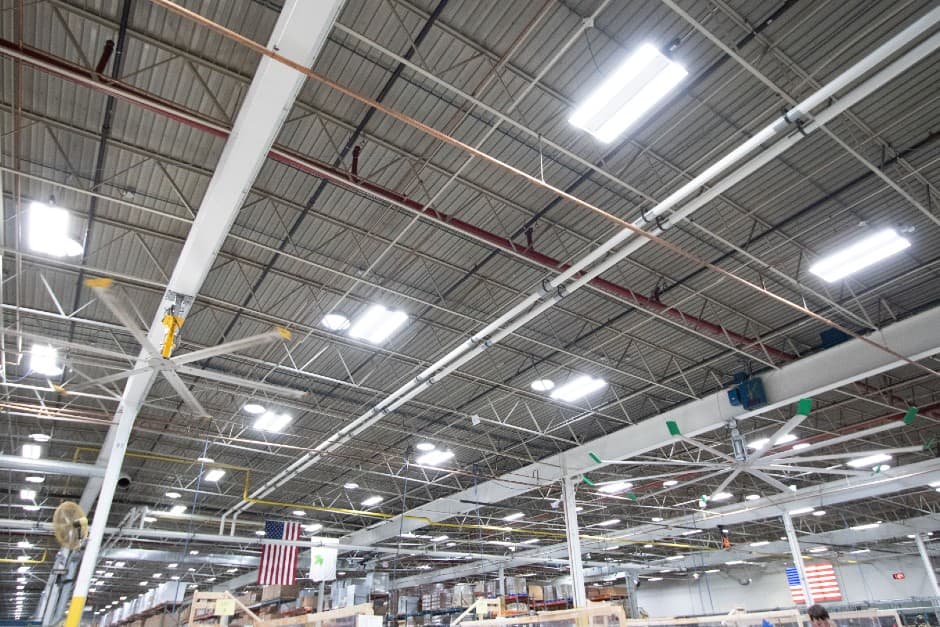The Top 4 Long-term Benefits of Commercial LED Lighting Retrofits

There’s a wealth of evidence demonstrating that commercial and industrial facilities of all sizes can realize meaningful benefits – in both the short and long term – from an LED lighting retrofit. From creating a safe and pleasant working environment to reducing overall operating costs, there are many human and business benefits associated with LEDs.
Here are some compelling facts and their potential long-term impacts.
1. LEDs Reduce Your Operating Costs
Reduced Energy Use.
Today, staying competitive in the marketplace is more important than ever, and organizations are looking at energy costs as an area where they might reduce expenses. Many are finding an LED lighting retrofit to be a solution.
Commercial LED fixtures use between 25% and 80% less energy than traditional lighting, and with incandescent lights being phased out by the Department of Energy (DOE) in favor of LEDs and compact fluorescent lighting, it’s estimated that by 2024 the U.S. will save $18 billion in electricity costs each year. The DOE projects that the majority of that savings will be driven by the increasing use of LED lighting in commercial settings (buildings and outdoor lighting). For individual businesses, this could mean thousands of dollars saved each year.
Longevity.
The lifespan of an average LED light fixture is about 50,000 hours – and as high as 100,000 hours. Using a warehouse that’s converted its old lighting to LED high bays as an example, if the facility operates 12 hours each day and 365 days a year, their fixtures will run for more than 10 years – up to 5 times longer than either compact fluorescent (CFL) or metal halide fixtures.
Think of this another way: A 100,000-square-foot warehouse with an average of 16 fixtures will go through 5 replacements (80 fixtures total) while a warehouse using LED fixtures will still be running its original 16 fixtures. In fact, the facility using LEDs can expect another year or more of use from its fixtures.
Reduced Heat Output.
CFLs turn about 80% of the energy they consume into heat, meaning only 20% goes to producing light. LEDs, on the other hand, emit almost no heat, significantly reducing the strain put on a facility’s HVAC system to maintain the ideal temperature for its workers and the products that may be manufactured and/or stored there.
Lower Total Cost of Ownership (TCO).
In addition to reducing an organization’s energy costs, a commercial LED lighting retrofit helps minimize operating expenses because they require fewer worker hours to maintain the fixtures (specifically, time spent replacing fixtures and/or replacing lamps).
As LED technology has advanced, the cost to manufacture these fixtures has dropped; this, in turn, has contributed to more widespread adoption. As a result, prices have dropped, making the transition to LED an even more attractive and strategic decision for organizations.
Financing options make the investment in LEDs both practical and affordable. Orion works with its customers to secure all applicable rebates and connect them with lenders specializing in funding these types of projects.
Durability.
The lights used in LED fixtures are very durable, making them the ideal choice for the harsh conditions in facilities such as warehouses and distribution centers. They’re resistant to vibration, shock, and impacts from external forces (because they’re designed with a resin-encapsulated chip rather than with a filament or gas, they’re less likely to break).
They’re also less vulnerable to the elements (cold, wind, rain, etc.), performing well in both high- and low-temperature environments. As the temperature drops, traditional lighting requires an increase in voltage in order to “fire up,” and the intensity of their light decreases. LED lights perform better in cold temperatures, by about 5%. This makes them the preferred choice for commercial freezers, meat lockers, cold storage spaces, refrigerated display cases, and a wide variety of outdoor applications.
RELATED: VIEW OUR COLD STORAGE PRODUCT GUIDE
2. LEDs Reduce Your Carbon Emissions
The new Department of Energy rules regarding traditional lighting are expected to reduce U.S. carbon emissions by 222 million metric tons over the next three decades – about the same amount generated by 28 million homes in one year.
By 2035, they expect the majority of lighting installations to use LED technology, and the associated energy savings could top 569 TWh (terawatt hours) annually – equal to the annual energy output of more than 92 power plants.
Because LED lights have the potential to make a significant positive impact on our environment, states and the federal government have put incentives and cost-reduction programs in place to help businesses retrofit their facilities to LED lighting.
3. LEDs Give You Flexibility
LED lights are available for nearly every indoor and outdoor commercial environment and application, and can be easily customized based on the desired beam spread, lumen output, and lighting control technologies. Review Orion’s Exterior Lighting Product Guide to learn more about the options available for light distribution, temperature, wattage, controls, lumen ranges, mounting types, and much more. You can also explore our wide range of indoor products and characteristics here.
4. LEDs Help You Attract Customers & Ensure Safety
According to QSR magazine, a trade publication for the restaurant industry, quality outdoor lighting contributes to a more inviting environment for both customers and employees, and helps ensure their safety. These feelings of safety extend to retail establishments as well.
LEDs provide precise lighting where it’s needed, giving people a level of comfort as they arrive and leave; they also help people and vehicles safely navigate outdoor spaces. Quality lighting has also been shown to reduce crime in some outdoor spaces, as it has a “signaling effect” of telling people the area is being watched and cared for.
The evidence is overwhelming, and confirms that only LED lighting delivers a broad range of positive benefits to its users. If your facility still features traditional lighting, it’s time to connect with a commercial lighting expert to understand all the LED options available. We encourage you to contact us today.
SOURCES
- U.S. Department of Energy, Energy Efficiency and Renewable Energy, “Lifetime of White LEDs.” PDF, Sept 2009
- U.S. Department of Energy, “LED Lighting.” undated
- SiteLogiQ, “Ten Advantages of LED Lighting.” Sept 2019
- Phillips, Anna. “Trump Saved This Old-fashioned Light Bulb. Biden’s Now Phasing It Out.” The Washington Post, April 2022
- Gibson, Kate. “Incandescent Lights to Get Switched Off in 2023 Under New Biden Rules.” The New York Times Moneywatch, April 2022
- Kaisler, Marissa. “Preventing Crime Through Good Lighting Design.” QSR magazine, October 2018
- Energy Star website, undated
- residencestyle.com, “How Many High Bay Lights Do I Need for My Warehouse?” November 2020
- Nickeas, Peter. “Nighttime Lighting Reduces Crime, But It’s Not A One-Size-Fits-All Solution, Study Says.” cnn.com, April 2022
- Freeingenergy.com, “Energy Fact - Cost of LED Lighting Dropped 15 Times as Volumes Increased.” undated
- Businesswire.com, “LED Market 2020-2024: Declining Manufacturing Costs of LEDs To Boost the Market Growth.” March 2020
- Wattlogic.com, “Metal Halide vs LED? Which is Better for Facilities?” January 2023
Subscribe to Energy Insights

How to Choose the Right Fixtures and Partner for an LED Retrofit

What to Know About LED Lighting for Manufacturing Facilities — Part 1

